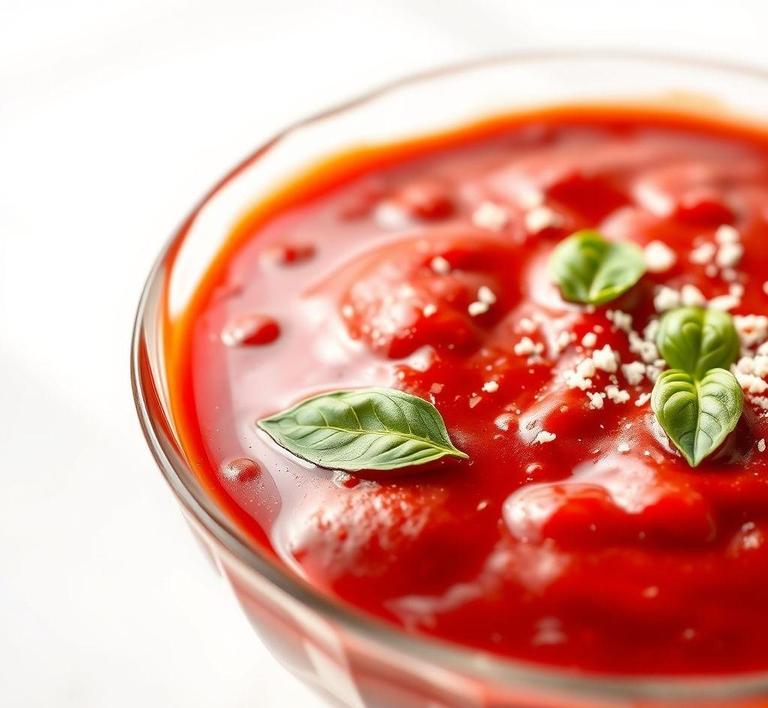If you’re someone who loves making a big batch of vodka sauce but doesn’t always finish it all, you might be wondering: can you refreeze vodka sauce? The good news is, yes, you can! Refreezing vodka sauce is totally doable, but there are a few important things to consider. For one, you’ll want to ensure the sauce has cooled completely before freezing it, and it’s best to store it in an airtight container to keep that creamy, flavorful texture intact. In this guide, we’ll walk you through everything you need to know about refreezing vodka sauce, from the best techniques to preserve its rich flavor, to tips on how to reheat it so it tastes just as fresh as when you first made it!
Can You Refreeze Vodka Sauce?

Vodka sauce is a rich, creamy concoction that blends the flavors of tomatoes, cream, and vodka-perfect for pairing with pasta or as a base for a variety of dishes. But what happens if you make too much, or have leftovers from a dinner party, and you want to save it for later? Is it safe to refreeze vodka sauce?
The short answer is: yes, you can refreeze vodka sauce, but there are important factors to consider when doing so. Refreezing any food, especially sauces, can sometimes cause changes in texture, flavor, and overall quality. Vodka sauce, being a cream-based sauce, is particularly sensitive to temperature changes due to its fat content. This means that while refreezing is possible, it’s not always recommended if you’re after the best possible result when you reheat it.
When vodka sauce is frozen initially, the water content (from the tomatoes and cream) can separate. When thawed, the sauce might become grainy or slightly curdled, and refreezing could exacerbate this issue, leading to a sauce that is less smooth and creamy upon reheating.
However, if you don’t mind a slight change in texture and you’re looking to store the sauce for a longer period, refreezing is definitely an option. The key is to freeze it as quickly as possible after the initial cooking to preserve the sauce’s integrity.
How To Refreeze Vodka Sauce?
Refreezing vodka sauce should be approached with care. Here’s a step-by-step guide to ensure that you do it as safely and effectively as possible:
-
Cool The Sauce Properly
Before freezing or refreezing, ensure that the vodka sauce is cooled to room temperature. Never freeze sauce that is still warm, as this can cause ice crystals to form, which will negatively affect the sauce’s texture when thawed.
-
Use Airtight Containers Or Freezer Bags
When transferring the vodka sauce to the freezer, choose containers that are airtight and freezer-safe. Glass jars, BPA-free plastic containers, or heavy-duty freezer bags are good options. These will prevent air from getting in and causing freezer burn, which can degrade the flavor and quality of the sauce.
-
Portion It Out
If you’ve made a large batch, it’s a good idea to divide the sauce into smaller portions. This way, you only thaw what you need, preventing you from repeatedly refreezing the same portion, which could lead to a more significant loss in texture and flavor.
-
Label The Containers
Don’t forget to label the containers with the date that the vodka sauce was first cooked or frozen. This will help you keep track of its age and make sure you’re using it within the recommended storage time. Vodka sauce can last about 3-4 months in the freezer, but the quality may deteriorate after that.
-
Freezing The Sauce
Place the vodka sauce in the freezer as soon as possible after it has cooled down. Try to avoid leaving the sauce at room temperature for too long, as bacteria can grow rapidly between 40°F and 140°F (4°C – 60°C). The faster the sauce freezes, the better it will maintain its original flavor and texture.
Quality Impact Of Refreezing Vodka Sauce
While you can refreeze vodka sauce, the quality will likely change after multiple freezing and thawing cycles. Let’s break down what might happen:
-
Texture Changes
Vodka sauce’s creamy, smooth texture is often one of its most attractive qualities. However, when frozen, the dairy components (cream and milk) can separate during the freezing process. Upon thawing and reheating, the sauce may appear grainy or slightly separated, as the fats don’t always re-emulsify easily. The result can be an unappealing, lumpy consistency that doesn’t quite match the original silkiness.
-
Flavor Deterioration
The fresh, vibrant flavors of a freshly made vodka sauce can also diminish with refreezing. Repeated freezing and thawing can weaken the intensity of the vodka’s kick and the tomato’s freshness. The sauce may taste a bit flat or less flavorful, and the natural sweetness of the tomatoes may be subdued.
-
Separation Of Liquids
As mentioned, refreezing may result in the separation of water and fats in the sauce. When you thaw the sauce, you might notice some watery liquid on the surface, which would need to be stirred back in. While this isn’t harmful, it can be annoying and may affect the consistency of the sauce.
-
Risk Of Overcooking
If the sauce is reheated improperly (e.g., too fast or too high of a heat), the cream can curdle or break, resulting in an unpleasant, split appearance. This is more likely if you are reheating a refrozen sauce compared to one that was fresh.
-
Freezer Burn
If the sauce isn’t properly sealed, air can make contact with the sauce, causing freezer burn. This is a phenomenon where the sauce’s surface becomes dehydrated, leading to off-flavors and a tough, unappetizing texture. While freezer burn doesn’t make the sauce unsafe to eat, it can make the experience far less enjoyable.
While you can refreeze vodka sauce, it’s important to be aware of the potential changes in quality. The sauce may lose some of its creaminess, develop a grainy texture, and experience slight flavor degradation. If you’re okay with these minor differences and need to store the sauce for a longer time, refreezing is certainly a viable option.
To minimize the negative impact on quality, ensure that you cool the sauce properly, use airtight containers, and don’t freeze and thaw the sauce too many times. By following these simple steps, you can enjoy your vodka sauce for longer without significant loss of its delicious flavor. However, if you’re aiming for the best texture and taste, it’s always better to avoid refreezing and instead store your leftovers in the refrigerator, consuming them within a few days.
Is It Safe To Refreeze Vodka Sauce?
Vodka sauce, a rich and creamy pasta sauce often made from a combination of tomatoes, cream, and vodka, is a beloved staple in many kitchens. Whether it’s served over pasta or used as a dip, this sauce’s texture and flavor can be the highlight of any meal. But when it comes to leftovers or meal prepping, one common question arises: Is it safe to refreeze vodka sauce?
In short, yes, you can refreeze vodka sauce, but there are some important factors to consider. The main concern is how the sauce has been stored, whether it has been properly thawed, and how long it has been sitting out. Vodka sauce, like most cooked sauces, is prone to texture changes and potential bacterial growth when mishandled, so freezing, thawing, and refreezing must be done with caution.
The vodka itself, being an alcohol, acts as a preservative, and the cream or dairy component can generally handle the freezing process better than some other sauces. However, the freezing and thawing process can affect the sauce’s consistency, causing it to separate or lose its smooth texture. But if you handle it carefully-freezing it soon after cooking, storing it in airtight containers, and avoiding multiple thawing and refreezing cycles-you can safely enjoy vodka sauce even after it’s been frozen and refrozen.
Signs That Vodka Sauce Should Not Be Refrozen
Even though it’s generally safe to refreeze vodka sauce under the right circumstances, there are some red flags that indicate your sauce has been compromised and should not be refrozen. These signs often relate to the texture, smell, or the way the sauce has been handled:
- Separation or Curdling: One of the most common issues with refrozen vodka sauce is that it may begin to separate when thawed. The cream could break, causing a curdled or oily texture. If you notice that your sauce has separated into layers of cream, oil, and liquid, it’s a sign that it may not refreeze well and could be difficult to reincorporate without losing its quality.
- Off Odor: If the vodka sauce smells sour, rancid, or off in any way, that’s a clear sign it’s gone bad. The sour smell could be a result of bacterial growth due to improper storage, such as leaving the sauce at room temperature for too long before freezing. In this case, refreezing will not make it safe to eat.
- Change in Color: Vodka sauce typically has a rich orange or pinkish hue. If it has darkened significantly or shows signs of mold, discard it immediately. Mold can form in sauces left too long in the fridge or when thawed and then refrozen.
- Slimy Texture: A slimy texture could indicate bacterial contamination. If your sauce feels slimy to the touch after thawing, it’s a good idea to throw it out rather than risk foodborne illness by attempting to refreeze it.
- Excessive Ice Crystals: If you notice that your vodka sauce is covered in a lot of ice crystals after thawing, that’s a sign that moisture has been trapped during the freezing process. This could affect both the texture and the flavor of the sauce once it’s refrozen.
Common Refreezing Mistakes
When it comes to refreezing vodka sauce, people often make several common mistakes that can lead to undesirable results, such as compromised texture or flavor. Here are some of the most frequent mistakes:
- Freezing Without Proper Cooling: One of the biggest mistakes people make is freezing vodka sauce before it has had the chance to cool properly. If you put hot sauce directly into the freezer, it can raise the temperature inside the freezer, affecting the quality of other foods. More importantly, putting hot sauce in a sealed container before cooling it can cause condensation inside the container, which can lead to freezer burn and a watery texture upon thawing.
- Not Using Airtight Containers: Vodka sauce, like any food being frozen, needs to be stored in airtight containers or heavy-duty freezer bags. If there’s too much air inside the container, it can lead to freezer burn. The sauce will lose its flavor, and the texture can become grainy or mushy. Always use a vacuum-sealed bag or a tightly sealed jar to ensure the sauce is as protected as possible from air.
- Refreezing More Than Once: Refreezing vodka sauce multiple times is a recipe for disaster. Each time the sauce is thawed, bacteria have a chance to multiply. Moreover, the sauce will degrade in quality with every thaw and refreeze cycle, losing both texture and flavor. Once it’s thawed, it’s best to use it within a few days and only freeze it once.
- Overfilling Containers: When freezing vodka sauce, it’s tempting to fill containers to the brim. However, overfilling can cause expansion as the sauce freezes, potentially causing the container to crack or break. It also doesn’t leave room for the sauce to expand, which can create a mess. Leave about an inch of space at the top of your container to allow for expansion.
- Thawing at Room Temperature: When you need to thaw frozen vodka sauce, avoid doing so at room temperature. Leaving the sauce out for extended periods can encourage bacterial growth, which can be harmful. Always thaw the sauce in the refrigerator overnight or use the defrost function on your microwave.
Tips And Tricks
To ensure that your vodka sauce stays as fresh and flavorful as possible, here are some tips and tricks to follow:
- Freeze in Small Portions: Instead of freezing the entire batch of vodka sauce at once, freeze it in smaller portions. This makes it easier to thaw only what you need, reducing the chances of refreezing multiple times.
- Use Ice Cube Trays: For even smaller portions, consider freezing your vodka sauce in an ice cube tray. Once the sauce has frozen solid, you can transfer the cubes into a freezer bag for more convenient use in the future.
- Reheat Slowly: When reheating vodka sauce after it’s been thawed, do so slowly on low heat. High temperatures can cause the cream to break, leading to an unappetizing texture. Stir the sauce frequently to help reincorporate any separated cream or oil.
- Add Fresh Cream After Thawing: If the sauce separates after thawing, you can try adding a bit of fresh cream while reheating it. This can help restore the smooth, creamy texture and improve the overall consistency.
- Label Your Containers: To keep track of how long your vodka sauce has been in the freezer, always label your containers with the date it was frozen. This will help ensure that you use it within a safe timeframe and don’t accidentally refreeze something that’s been sitting around too long.
- Add Fresh Herbs After Reheating: For an extra burst of flavor, consider adding fresh basil, oregano, or other herbs after reheating your sauce. This helps refresh the flavors and adds a nice aromatic touch to the dish.
Conclusion
In conclusion, refreezing vodka sauce is generally safe, but it requires careful attention to the storage and handling process. By properly cooling the sauce, using airtight containers, and avoiding multiple refreezing cycles, you can ensure that your vodka sauce remains safe to eat and retains as much of its original texture and flavor as possible. Pay close attention to signs of spoilage, such as an off odor, separation, or changes in texture, and don’t be tempted to refreeze if the sauce shows any of these signs.
If you follow the right steps and avoid common mistakes, refreezing vodka sauce can be a practical way to preserve leftovers and make future meals easier. However, the key is to freeze and thaw the sauce properly, so you can enjoy it just as much as when it was first made. With these tips in mind, you’ll have a delicious, creamy vodka sauce ready to use anytime you need it!


